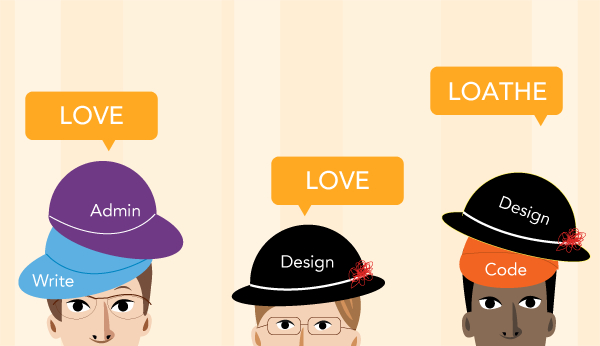If you’re like most small businesses, everyone wears multiple hats. We’ve found that swapping around hats between team members, has helped us drive better results and build a more engaged team.
The Problem with “Same Old, Same Old”
Sometimes as a business owner or manager, you can feel overwhelmed by everything on your plate. In fact, it’s probably more common than not to feel that way. At the same time, you may notice others on your team are feeling bored or complacent either because they’re not busy enough or the work they’re doing isn’t challenging enough for them.
This can cause an array of issues. When too much responsibility is solely on one individual, it can lead to burnout. When you’re not balancing the workload as a team, you can create resentment or a hostile work environment. And when people are complacent and unchallenged, it can cause them to leave your organization as they look for more challenging work elsewhere.
If you’re experiencing any of these scenarios, shifting responsibilities in your team may be the answer to building a team that’s more engaged, balanced, and more effective.
Increasing Engagement
Daniel Pink’s book Drive: The Surprising Truth About What Motivates Us, says that more than 50% of people in the US are not engaged with their work, which leads to unproductive work.
Pink explains that to increase engagement and productivity, you need to drive motivation through intrinsic motivation rather than extrinsic motivation. Extrinsic motivations are things like money and fame, which eventually wear off and cause people to lose motivation again. Intrinsic motivation is the drive from within to do meaningful and purposeful work.
Pink explains that once basic financial needs are met, people are motivated by three desires: mastery, autonomy, and purpose. In a nutshell, people are more engaged when they’re given the opportunity to master a specific skill, given autonomy to work and solve problems how they want and are doing meaningful work.
Employees are often looking for new challenges, new responsibilities, and new growth opportunities. But in a small business, creating space for people to “move up the ladder” isn’t as easy as corporate companies.
Shifting roles and responsibilities between team members in a small business can create space for learning and growth within your company. It gives employees new ways of being challenged and learning new skills. And by giving team members the opportunity to choose what new roles and responsibilities to take on, it gives them more autonomy.
Experiment Part 1: Swapping Hats
As our company has grown and evolved, we’ve done a lot of shifting. People have moved around to different departments, new teams have formed, tasks have shifted between people, and employees have even switched roles and responsibilities entirely. We’ve had a lot of changes in roles within the company, but I’ll explain specifically how we’ve done this within our marketing team.
As a marketing team of three people, we decided to experiment shifting roles and responsibilities with two objectives in mind; balance the workload and give each team member an opportunity to learn a new skill.
We started by writing out all the different “jobs” that our marketing team was responsible for along with a few bullet points to describe what was involved in each “job”. We reviewed the list and got into a productive debate about what jobs were necessary to continue doing, what jobs should be paused for the time being, and what jobs should be outsourced. While it’s tempting to do everything, we knew that staying focused was critical to achieving success and driving better results.
After we agreed on the final list of jobs to be shared between the three of us, we went through each job and gave everyone a chance at taking the job to own it. We made it clear that owning a job didn’t mean you’re the only one doing the work involved, but it does mean you’re expected to take ownership of the strategy, coordination, and results of that job.
After about an hour of discussion, we each had a more balanced list of jobs.
The Results of Swapping Hats
At first, it was a bit challenging to get used to the shift, but within the first few months of this exercise, I noticed a big change in the team. We were way more excited and motivated about our work, and we were collaborating more as a team. On certain projects, one person would take the lead and drive the conversation to come up with new ideas to tackle problems. Then on other projects, that person would take a backseat and offer ideas while someone else took the lead.
We each felt more ownership over our jobs, we were learning faster, solving problems faster, and we understood the purpose and the impact our work had overall. Additionally, we were achieving better results because each job had someone owning it and really driving efforts. We felt more focused, and it became easier to say “no” because we could to identify distractions better than when we shared ownership.
Experiment Part 2: Love/Loathe Exercise
After experimenting with the new roles, we did another exercise – the Love / Loathe exercise. This is another tip from the Rockefeller methodology that we follow. For this exercise, the purpose was twofold; give each team member more of the work they enjoy doing, while minimizing the work they don’t enjoy doing.
Each team member wrote out a list of their responsibilities and the types of tasks they perform. Then we separated those jobs and types of tasks into two columns – the “love” list and the “loathe” list. I’m super indecisive, so I also created an “indifferent” column for things we don’t mind doing, but wouldn’t be heartbroken if they were moved onto someone else’s list.
We then reviewed each person’s lists. Again, we started by evaluating each “job” or responsibility and decided that some jobs needed to be put on the back burner, while others became a priority and focus.
When it came to responsibilities and tasks on each person’s “love” list, we brainstormed ways we could incorporate more of that type of work into their role. For each task on someone’s “loathe” list, we asked if anyone else was interested in taking it over. It amazed me to see how tasks on one person’s loathe list, ended up on someone else’s love list!
The overall results
Even in a marketing team of only three people, shifting responsibilities between us has had a positive impact. By giving each other ownership over specific responsibilities, it’s allowed us to achieve better results. We’re more focused, more motivated, and more collaborative. We lean on each other for help and respect each other’s decisions when it comes to their area of expertise.



